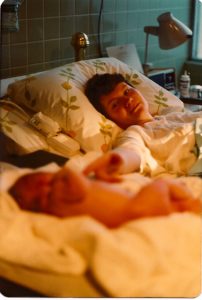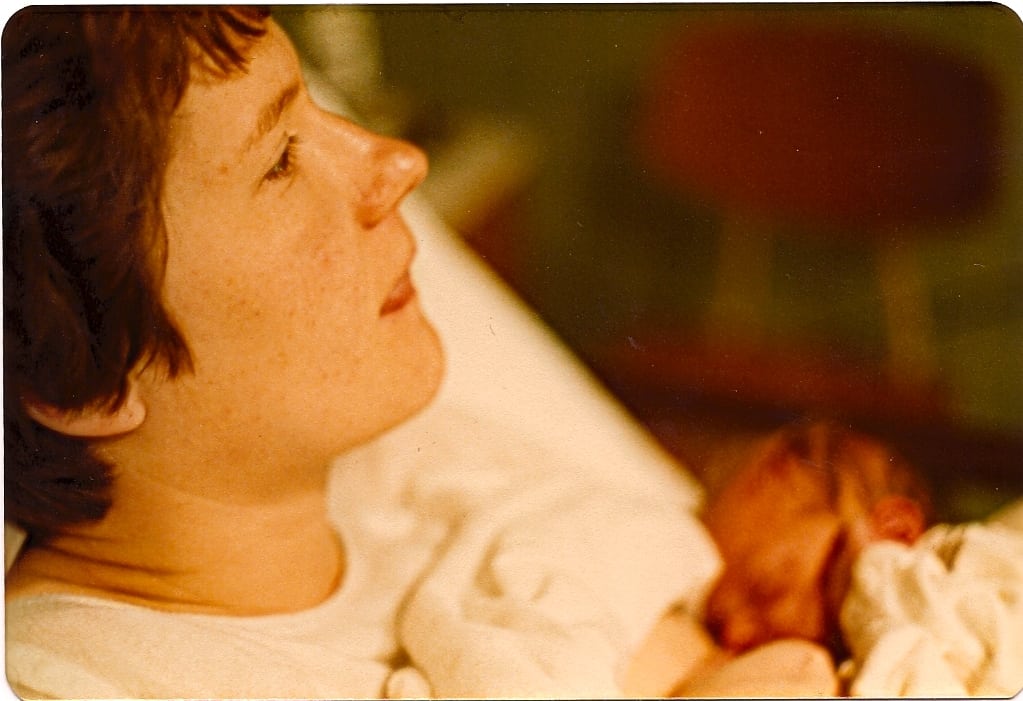I grieve we didn’t get to gather around a giant sacred fire and walk our candles into a darkened church to the sound of the Exultet.
I grieve we didn’t get to don our flowered dresses and pastel-colored bow-ties and leave that same church singing full-throated with the choir, “The Strife is O’er” – which never fails to make my shoulders tingle as the timpani trembles beneath our joyful uproar.
I grieve there was no egg hunt with my little legion of nieces and nephews.
And I grieve not gathering in a tulip-fragranced hall with the eighty-some Jesuits with whom I live to share in our annual Easter morning brunch.
*****
Before any of the shelter-in-place orders took effect, while Coronavirus was still a strange happening on cruise-liners “over there,” I visited two good friends who had just given birth to their firstborn child – Rosie. They had asked me to be her godfather, which made me even more excited to welcome her to the world. She was beautiful and tiny and fragile. I noticed her eyes were like two loose marbles in oval picture frames, wobbling here and there around the room, unfocused and quivering.
After a time, I thought: Well, I guess she’s just going to sit there, a lump on a blanket, doing nothing. It was a funny thought, as I am after all a proud uncle to thirteen. Unless you’re the parent, I have to say that newborns aren’t all that exciting to be around. Soon, my friend’s sweet, rambunctious pound-mutt caught my attention. She never fails to shower me with affection – dog kisses and nuzzles – which, for a celibate like me, can be the highlight of the week!
*****
Four years ago, I provided an interactive art retreat to a group of Jesuit high school faculty. This week I came across some notes from the retreat. It read:
Consider a newborn baby.
This newborn can be awake with eyes wide open, yet its vision is by no means fully developed. In truth, they must learn to see; the process is gradual. Though bombarded with all kinds of new visual stimulation, the reality is that newborns see little more than the difference between light and dark in those first couple of days and weeks. Slowly, forms, shapes, patterns and dimensions become increasingly discernible. Before they ever reach and grab with their hands, crawl or sit, walk or talk, the newborn must, wherever they happen to be placed, explore the world around them with their eyes. And the first thing that comes into focus are those objects eight to ten inches away – about the distance between their face and that of their caregiver.
My perception of Rosie just sitting there, doing nothing could not have been further from the truth. Under the surface she was buzzing with activity. In her stillness, she was diligently, mightily, silently, learning to see.
*****
On the last phone call with my parents, they asked: “So, what lessons are there in all of this Coronavirus, lockdown, business, you think? What is this Easter going to mean to you in light of all that’s going on?”
“I honestly don’t know,” I responded.
People have offered their interpretations: It’s a punishment from God; It’s a sign that the end days are near; The Lord works in mysterious ways.
I’ve ruled these out. But I’m still left groping for answers. Luckily, I have exemplary companions.
John wrote: “Early in the morning, on the first day of the week, while it was still dark, Mary Magdalene came to the tomb” (Jn 20:1). It was only after stumbling in the dark and mistaking Jesus for the gardener that Mary recognized him.
Those apostles in the upper room fared no better. In frenzied disbelief at the incredulous sight, they confuse Jesus for a ghost.
Though there in the flesh, Thomas insists doubt until he can reach out and touch his friend whose death he just witnessed.
And the disciples headed toward Emmaus, they only came to recognize their risen Lord after having walked with him the whole day.
Easter spirituality doesn’t offer sudden and final jolts of perfect realization. If the spiritual life is learning to wake up, or to see, as it were, this implies a gradual process. Confusion, anxiety, disorientation, and grief, even, are not excluded from the Easter experience.
*****
When the cacophonous, bustling city of Wuhan was forced to shut down, they said songbirds could be heard again. I don’t know if this is true, but it’s a lovely image, isn’t it?
From my bedroom window, where I am spending more time than usual, I’ve noticed buds on the trees start to form and the tulips pushing up on the other side of the street.

Author’s mother, Mary, with first born daughter, Jennifer Joy, 1980.
T.S. Eliot believed we must continue explore, despite any silence, through whatever cold, dark, desolation, or supposed immobility:
Here and there does not matter
We must be still and still moving
Into another intensity
For a further union, a deeper communion.1
The churches are empty this Easter. Rosie’s baptism is postponed indefinitely. But our spiritual exploration and learning to see with Easter eyes continues. Out of our experiences – however hazy or amorphous – the face of the Lord will be revealed in contours and detail we might have otherwise missed. As our vision grows more acute, we will be taught to respond accordingly. It just might happen more quietly – in stillness – from wherever we happen to be placed.
-//-
Photos courtesy of the author.
- T.S. Eliot, “East Coker”, 1940. ↩


